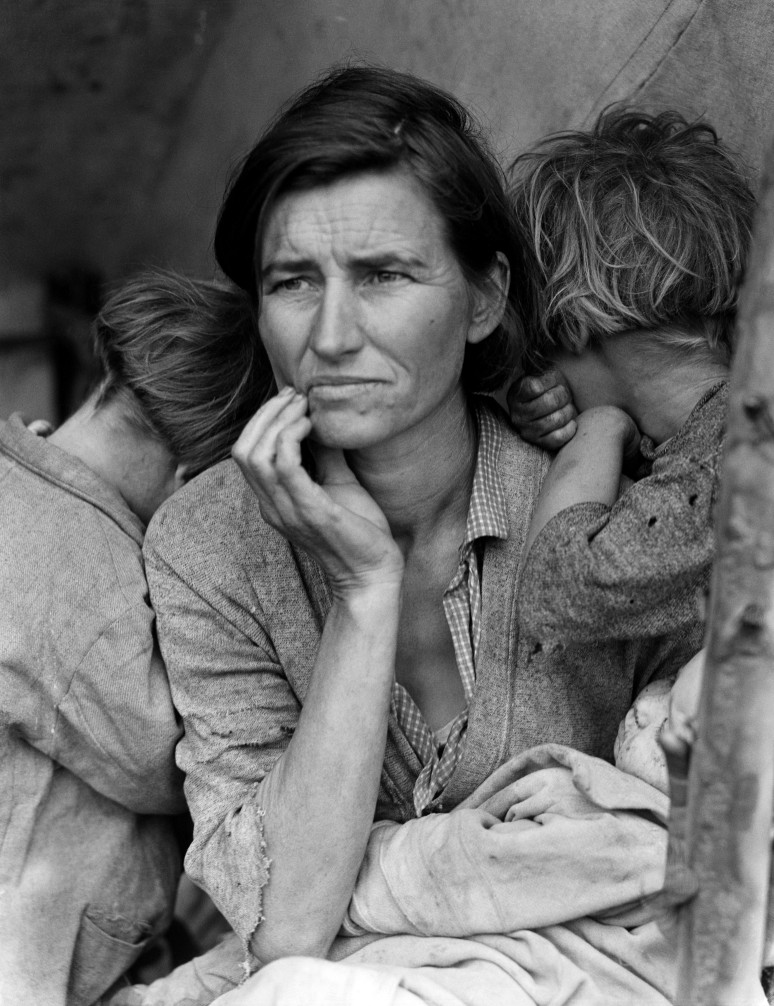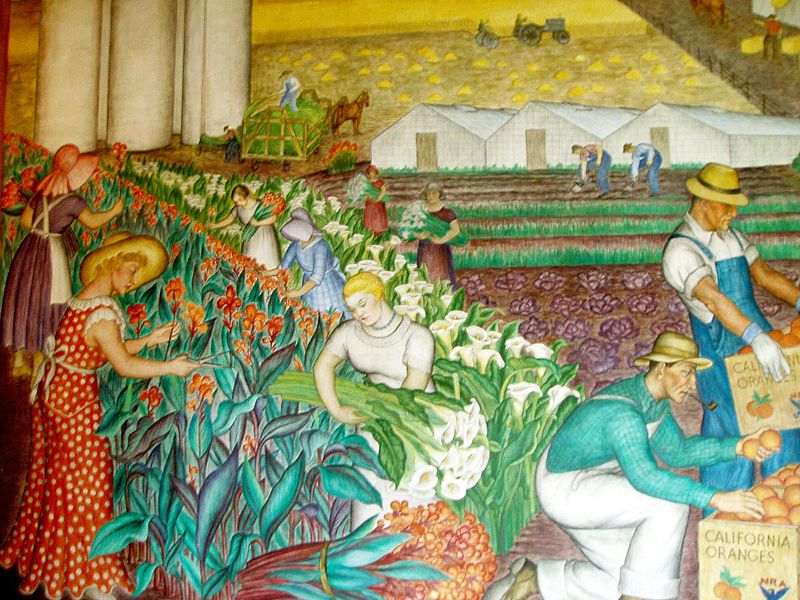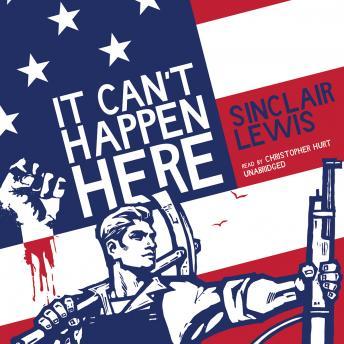Something that most people don’t think about when they think about the Great Depression is art. But in reality, the Great Depression had a large influence on art in the United States. Outside of the inspiration it may have brought to artists, the President of the United States at the time (Franklin D. Roosevelt) implemented a job program in order to make jobs for artists. This program was called the Public Works of Art Project (PWAP). It hired 3,749 artists and produced 15,663 paintings, murals, prints, crafts and sculptures for government buildings around the country. The New Deal not only put Americans to work in art (and many other industries), it also celebrated American workers, the nation’s history, its talents, and its diversity. This is evident in the art produced during the New Deal and Great Depression.
Before I get into art from the New Deal, I’d like to start with one of the most famous photographs from the New Deal:

Migrant Mother
Dorothea Lange’s Migrant Mother depicts a pea picker in California. Pictured is Florence Owens Thompson, a mother of seven children, in Nipomo, California. This is so iconic because it embodies the struggle of the Great Depression. It shows how absolutely devastating and challenging times really were. (I’d recommend reading this Wikipedia page on Florence https://en.wikipedia.org/wiki/Florence_Owens_Thompson ). Not only does this picture truly embody the struggles of the Great Depression, but the photographer, Dorthea Lange, actually became employed by the government in the Farm Security Administration. This shows how many people the government ended up employing during the New Deal and it’s influence on art.
Next I’d like to show a piece that was directly a result of the New Deal. This next piece was painted by Maxine Albro (one of the few women employed by the Public Works of Art Project).
 California
California
California, by Maxine Albro was painted in 1934 in California. She painted in under commission for the Coit Tower in San Francisco (where it still resides today). This mural is a great example because it results directly from the New Deal and Great Depression. It shows people working and tries to embody America. The idea of the commissioned arts in the New Deal was to show America as it is and create a sense of pride. This image does that by portraying working Americans and being put in an iconic American building. The painting depicts the bounty of American (specifically Californian) farming and agriculture – something Americans could have pride in. Another fun fact about this painting and artist was the uniqueness of employing women. The New Deal project marks the first time women were hired without discrimination (due to the requirements of the job programs in the New Deal).
A similar project that grew from the Great Depression and New Deal was the Federal Theater Project, which was designed to create jobs for unemployed theater writers. This program created many plays that reached broad audiences. One that I think is especially interesting (because it has come back into relevancy today) is It Can’t Happen Here by Sinclair Lewis. This was a novel adapted as a play in 1936 by Lewis and John C. Moffitt; it was written during the rise of fascism in Europe and emphasizes liberal values of personal freedom. These are very American ideas. Further, the play was borne from the Federal Theater Project and traveled around America being shown in many cities.

“Why are you so afraid of the word ‘Fascism,’ Doremus? Just a word–just a word! And might not be so bad, with all the lazy bums we got panhandling relief nowadays, and living on my income tax and yours–not so worse to have a real Strong Man, like Hitler or Mussolini–like Napoleon or Bismarck in the good old days–and have ’em really run the country and make it efficient and prosperous again. ‘Nother words, have a doctor who won’t take any back-chat, but really boss the patient and make him get well whether he likes it or not!” (excerpt from “It Can’t Happen Here”)
What is really interesting about this play, is that people are paralleling it to Donald Trump and his sudden popularity in the United States. Here is a really interesting article on it from the New York Times: http://www.nytimes.com/2016/09/26/theater/a-play-timed-to-trumps-candidacy-asks-what-if.html
My Ideas on These Pieces
I think that the photograph by Dorthea Lange is very powerful. It shows a lot of emotion wrapped into one still image. The image really shows how hard the Great Depression is, and with the kids leaning on the mom, it really pulls at the heartstrings. Photography can be very powerful because it shows real people. Wheras paintings can be hard to empathize with, photography truly shows real people, which I think invokes a very empathetic response.
On the other hand, while I appreciate the art created by the New Deal in the buildings, I don’t get a lot of feeling from it. Albro’s piece California, while objectively very good, does not invoke feeling from me. It’s not that I don’t like the piece, I just feel very emotionless about it. It reminds me of all the pieces in historical buildings/city halls (which makes sense because that is what it is and was made for), which I can say “wow that’s a nice painting” but I just appreciate it in passing by rather than truly emotionally.
The third piece, the play/novel, while I haven’t read the entire thing, it is something I am interested in doing. I really enjoy political plays, and it created such a whirliwind in American I am incredibly curious. Especially with it’s relevance nowadays. I skimmed the novel on Project Gutenberg (as much as I tried, I honestly couldn’t find the play adaption) and I actually downloaded it on my Kindle to read. While I know it’s not fair for me to say I enjoy the piece, I honestly feel like I really will. So I’m going to be pre-emptive and say that I enjoy it. I enjoy art that makes you think, and It Can’t Happen Here certainly fits the bill.
This play
https://en.wikipedia.org/wiki/Maxine_Albro
http://gutenberg.net.au/ebooks03/0301001h.html
https://en.wikipedia.org/wiki/It_Can%27t_Happen_Here
http://www.nytimes.com/2016/09/26/theater/a-play-timed-to-trumps-candidacy-asks-what-if.html
https://en.wikipedia.org/wiki/Florence_Owens_Thompson
https://dp.la/exhibitions/exhibits/show/the-show/the-plays/modern-drama
You’re right that many people do not know a lot about the art of the Great Depression. In particular, I found your comments on Sinclair Lewis’ play interesting. I am always interested in ways art is used to further a political view. While we had interesting plays like this, in Germany where they also suffered from the Great Depression, they also used art to further the Nazi party. Filmmaker Leni Riefenstahl released The Triumph of Will in 1935 which is praised for its artistic camera techniques but also helped popularized the Nazis. So here we have two contrasting works of drama, one promoting fascism and the other countering it. It’s just interesting to look at them both.
LikeLike